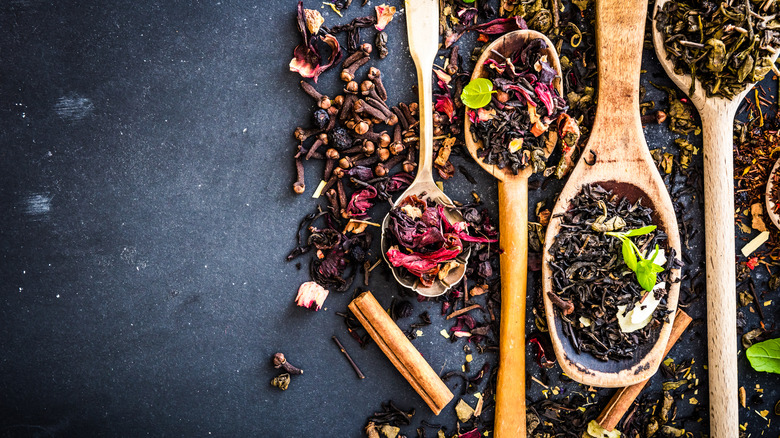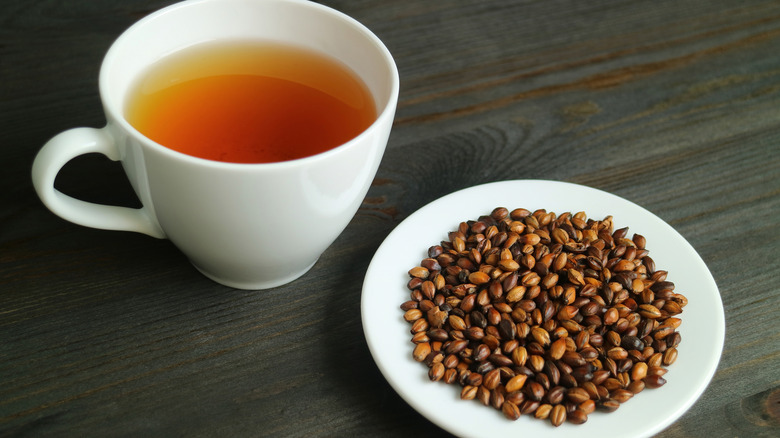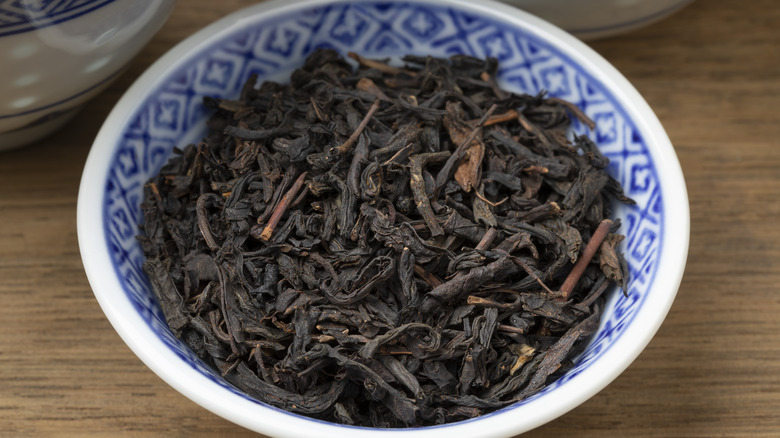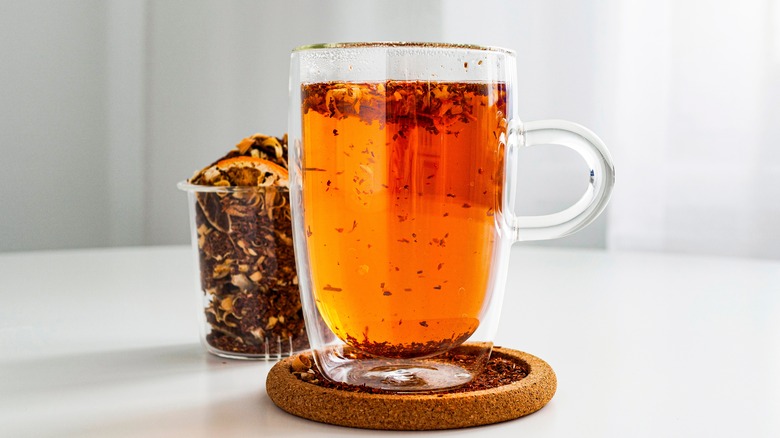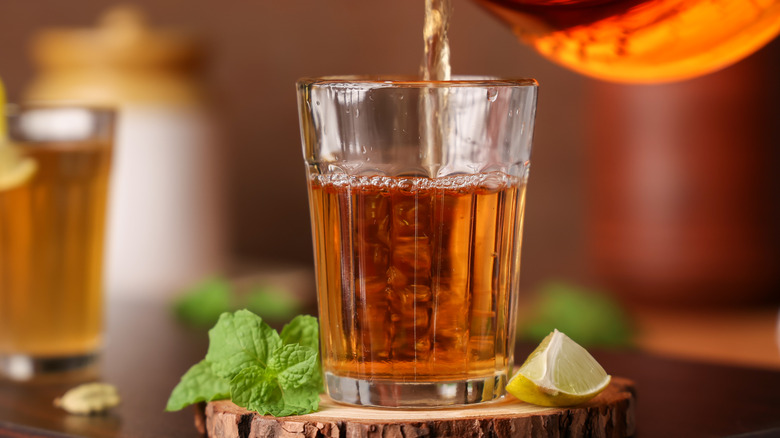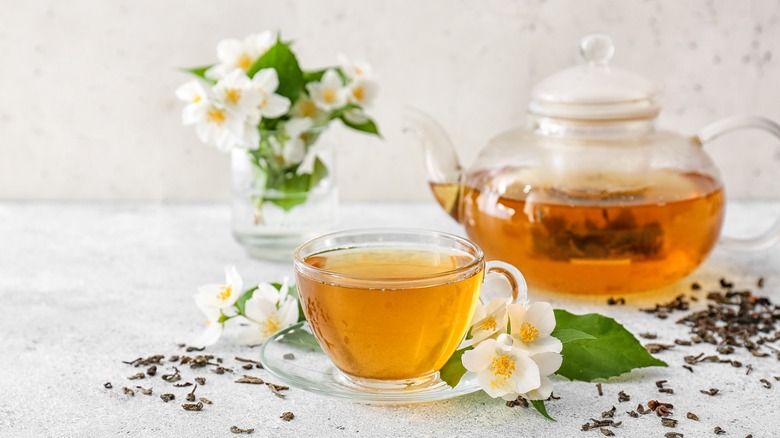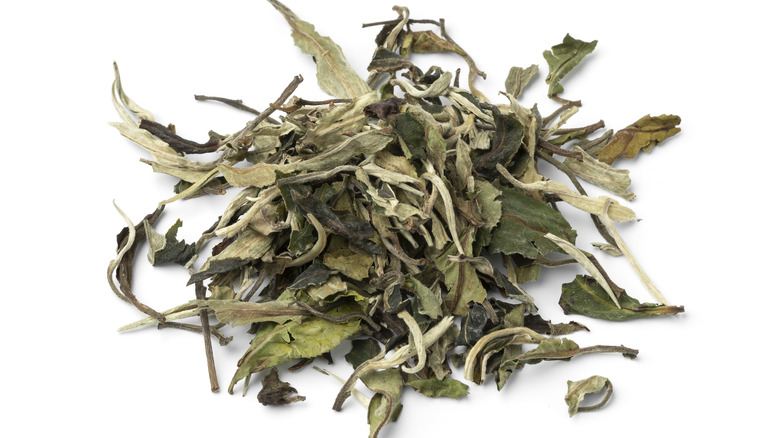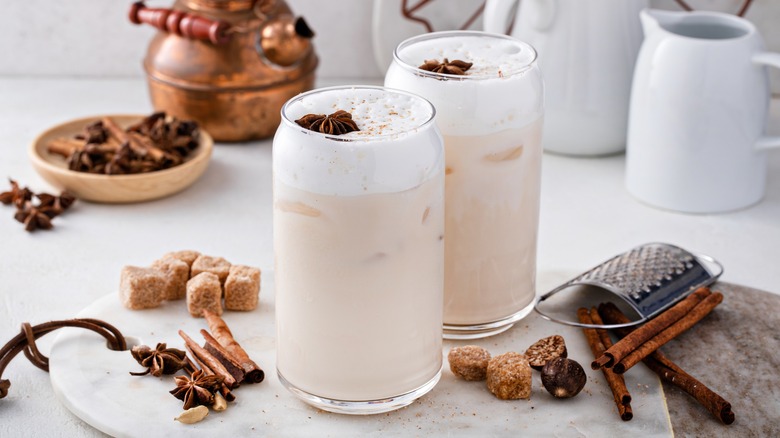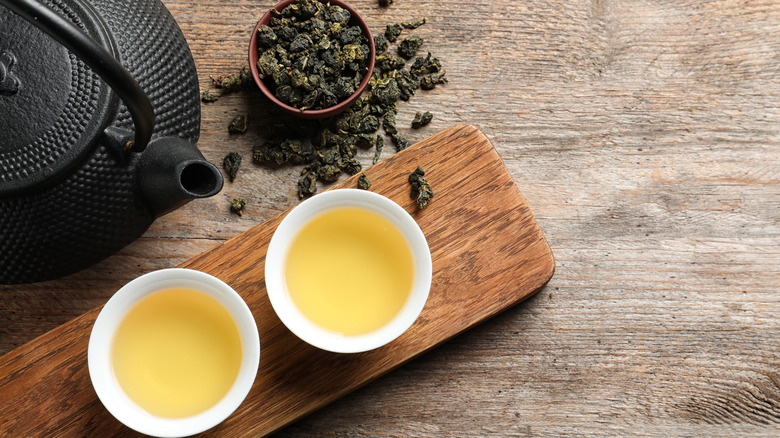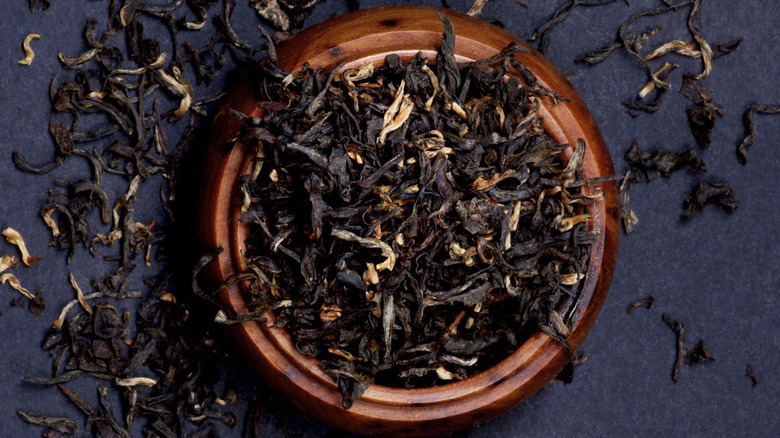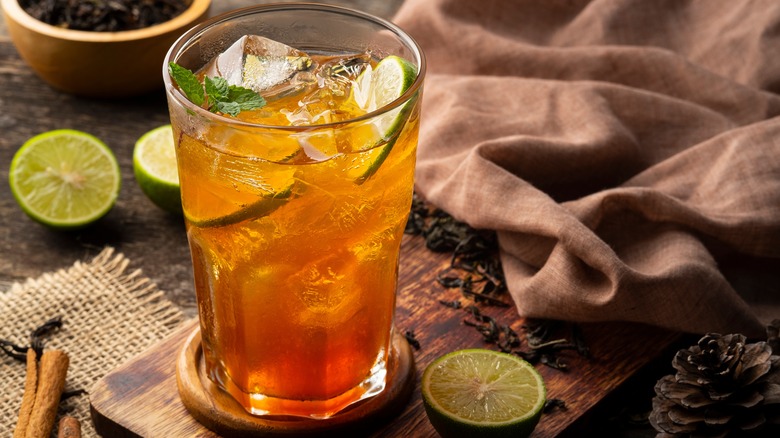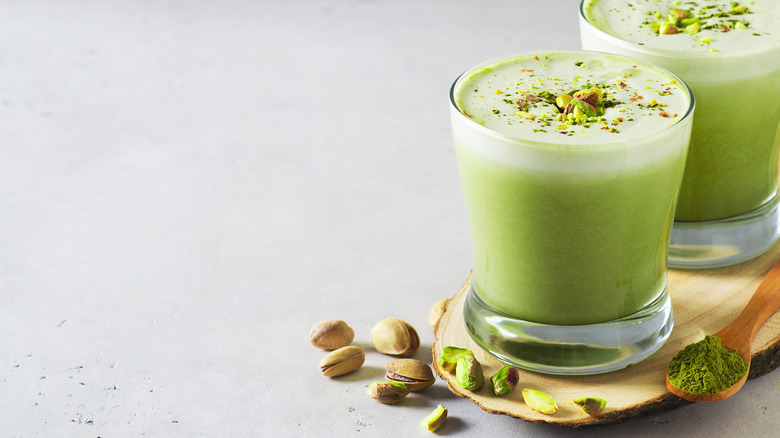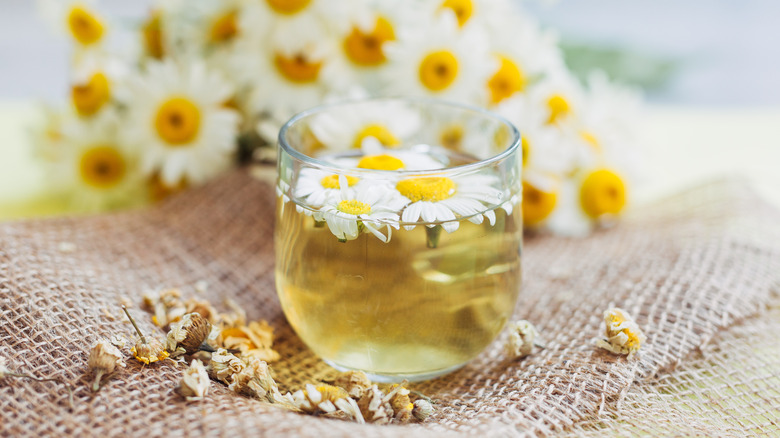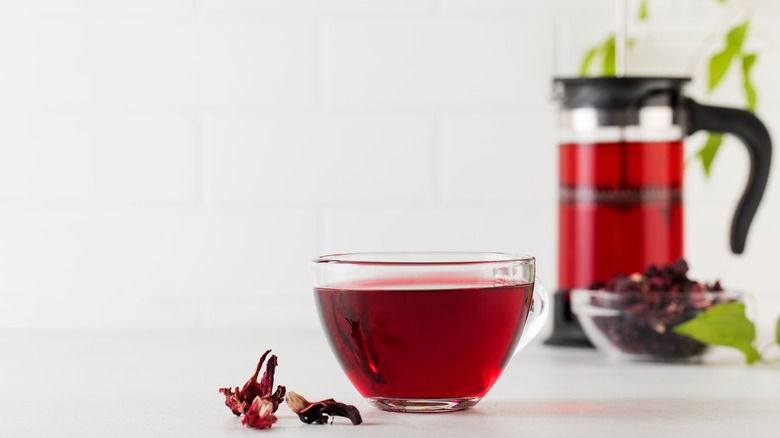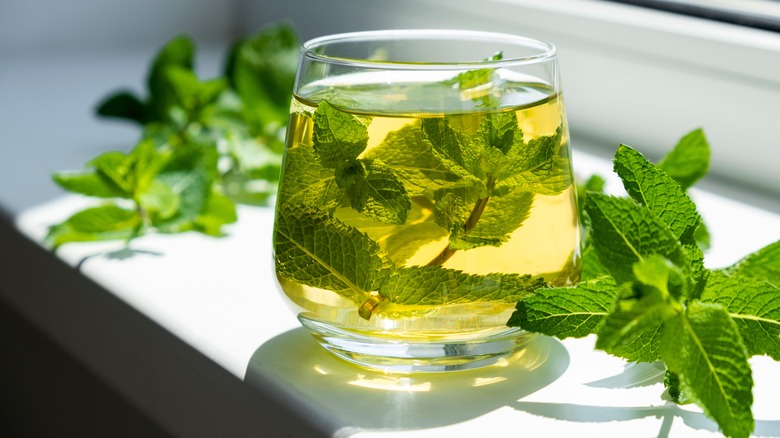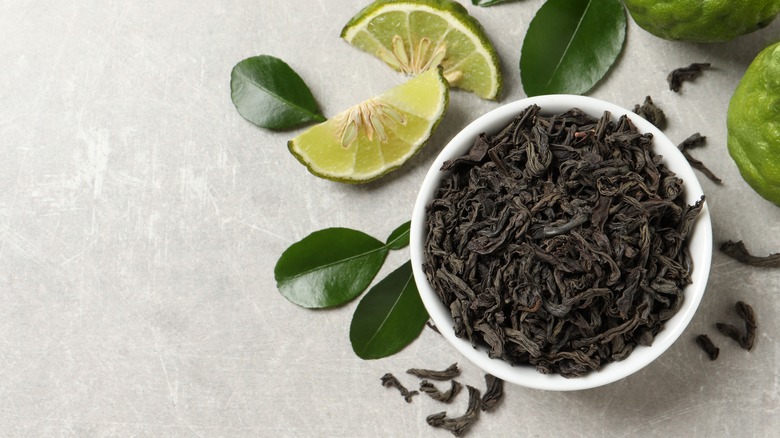15 Best Teas For Making Iced Tea, Ranked
Humans have been consuming tea in its various forms for centuries all across the globe. Ancient China was the first known producer of tea, but traders brought it to Europe in the 17th century, and from there, it was taken on to the Americas by European colonizers. But all that tea was mostly consumed hot. It wasn't until about two centuries later that a cold version of tea to appeared, thanks to a Missouri tea grower who thought southern summers were far too hot for drinking warm brews.
Tea now comes in many varieties, most notably black tea, green tea, white tea, and herbal infusions. Some of these make great iced teas on their own or mixed with fruit or juices, while others only work well when combined with complementary ingredients. For example, some black teas can taste bitter when made into iced tea. That's because heat can easily mask this bitterness in the hot version of the beverage, but colder temperatures can't necessarily achieve this unless the tea is combined with fruit or other ingredients. So let's take a look at which teas fare best in iced form.
Barley tea
Barley tea, also known as mugicha in Japan and boricha in Korean, is a blend made from unhulled roasted barley and is often drunk cold rather than hot. It has been consumed in Asia for centuries, in part because of a belief in its curative properties, which are said to include weight loss, blood sugar regulation, and improved digestion. The flavor tends to be nutty and savory, which strays a bit from the typical American preference for sweet iced teas, though some Korean manufacturers add corn to the barley to increase the tea's sweetness.
In addition to its unusual flavor profile for an iced tea, it is also a bit more work to prepare at home than your typical iced tea. If you can't find it in the tea aisle in your local health foods store or at the Asian market, you can brew it yourself from scratch by roasting the barley and cooking that for up to 20 minutes. After you let it cool, you can pour it over ice and add sweeteners to taste, or even some spices, such as cardamom. You'll end up with a drink with a rich flavor, which may or may not be exactly what you crave in the sweltering heat.
Lapsang souchong
Lapsang souchong is famous for being incredibly smoky. That's because instead of being air dried over time, this tea leaf is dried by blazing pinewood fire, giving it a naturally smoky essence that comes through loud and clear even after the brewing process. After the blaze, the leaves are allowed to oxidize at length to become black tea. All this makes lapsang souchong a great tea if you can handle the novelty of the smoke, but be aware that many people can't. If you're expecting a halfway regular tea flavor and are given Lapsang souchong, you're going to be in for a bit of a shock. But arguably, the smokiness makes this tea an even better option for an iced beverage. Simply prepare it as you would with any of your favorite black iced tea recipes.
If you're not up for the smokey profile, you can make also make lapsang souchong into a great iced tea mocktail with maple syrup, freshly ground pepper, lemon juice, and egg white. The smokiness and the pepper make a complex, multi-note beverage that could fit on any menu.
Rooibos
Rooibos is an herbal blend made from a bush that, so far, only grows in South Africa, despite farmers' efforts to harvest the plant elsewhere on the planet. This makes the product incredibly special. The flavor is also fairly unique. Depending on your blend, you might get hints of vanilla, honey, geranium, caramel, and all that good stuff in between. This richness and depth of flavor lend themselves well to all sorts of brews, including iced tea.
Rooibos also goes well with oranges and other fruits, which works out well if you're trying to avoid added sugars. This means you can make this delightful orange and rooibos iced tea, where the oranges and clementines pack plenty of natural sugars. Start by brewing your loose-leaf rooibos tea in boiling water for about three minutes. After this, all you have to do is refrigerate until cold, then serve over ice with a few squeezes of orange juice.
Green tea
Green tea is often an acquired taste. Its grassy flavor, which can vary from mild to uncomfortably intense and sometimes even downright odd, has been known to turn off perspective drinkers. But green tea is also famous among the healthiest teas to drink, hot or cold. Along with its powerful antioxidant punch and brain boost, studies have also found that green tea can improve the body's ability to break down fat and may even be able to reduce the risk of contracting certain types of cancers. None of this is certain, though, so let's focus on the taste and simple enjoyment of drinking a good cup of green tea in chilled form.
There are two great suggestions for this department. A simple iced green tea requires nothing more than water, green tea bags, an orange, a lemon, and some honey. For a more adventurous take, try this berry-infused version, made with lightly crushed raspberries and strawberries, berry-flavored green tea bags, and some honey or agave nectar. If you're not a big fan of hot green tea, give these a try instead. The cold fruit in these iced beverages will turn that grassiness into a much softer flavor.
Jasmine tea
Jasmine tea can be any type of tea that has been flavored with jasmine blossoms, though you will typically find green tea as the base. Jasmine has a powerful floral flavor that easily masks the dry grassiness of simple green tea. When you prepare your iced version, you're still going to taste it despite the dampening effect that temperature reduction has on taste buds in the perception of sweet substances, such as sweetened iced tea (via the Journal of Chemical Senses).
To prepare your iced Jasmine tea, just follow your favorite iced tea recipe and use Jasmine green tea instead, or you can opt for its black tea, white tea, or herbal varieties. The key thing to remember is that the water temperature matters when steeping iced tea bags, especially depending on the variety of tea. For example, it's important to brew green tea at lower temperatures than black tea, as boiling water more easily destroys the properties of green tea.
When making white, green, or jasmine tea, be sure to take your water off the flame somewhere between 175 and 180 degrees Fahrenheit. Failing to do so will not ruin your drink, but you won't get the most out of its flavor. It's a delicate process that should factor into your choice of tea for iced tea.
White tea
White varieties make a very delicate tea due to receiving the least amount of oxidation time compared to black tea. With that in mind, white teas will produce very delicate iced teas. So if you're looking for intense flavors, steer clear of white tea. In fact, it's best not to get too complicated. Keep your recipe simple, and you'll be able to enjoy white tea's subtle flavor. Just remember that this type of tea needs to be steeped at a lower temperature than black tea, meaning at just around 175 degrees Fahrenheit.
You can make white tea as you would for any other simple iced tea recipe. Or you can add a few summer fruits. We recommend this iced white tea with pear recipe, as the gentle pear flavors won't overwhelm the white tea. Citrus fruits can also go well with this drink, but be careful not to add too much lemon or orange, as white tea is an easy flavor to lose.
Chai
In many languages, most notably Hindi, chai is simply the word for tea. Even so, chai is very much its own thing, which is essentially spiced tea, though it can come in many different varieties. Historically, it contained only spices, namely cinnamon, cardamom, ginger, and black pepper. But after British colonization, black tea was added to the mix, and today most chai you find at the supermarket will be considered black tea. The addition of milk and sugar was also a result of the influence of the British, who, to this day, add a dash of milk to pretty much any black tea.
The result is the chai we know in America today, particularly in the form of chai latte, which is a mainstay in many coffee and tea establishments in the winter. The good news is that chai lattes can be just as enjoyable when cold. Chai can be a bit inconvenient for iced tea. It takes a lot of time to steep, around 12 hours, but the baking spice flavor still emerges in a muted form. And if spice is your thing, you can enhance it by adding sugar instead of honey, as this element brings out the spices in a more pronounced way.
Oolong
There is black tea, and there is green tea, white tea, and shades of gray. This is the space where you will find oolong. This tea is made with a somewhat unique process: in addition to the oxidation element, oolong tea is set out in the sun to dry, whereupon it acquires its famous twisted shape.
Oolong pairs very well with cinnamon, which is why we think you should try this iced cinnamon oolong tea. You can serve this cold as is or with a tad of sweetener. And if you want an even more flavorful drink, consider using loose tea leaves instead of tea bags. That's because tea leaves are purer than tea bags, which tend to include dust from tea processing. They're also fresher compared to tea bags, which have a tendency to sit on shelves for months on end, slowly losing their flavor and intensity. Oolong is a type of tea that is particularly strong, and its flavor holds up well under colder temperatures.
Assam tea
Assam is a popular type of black tea that comes without bells and whistles, meaning it contains just tea leaves and no added flavoring. It's the ideal no-nonsense tea. It is grown in the Assam region of India, and it is often what's used in English breakfast teas, which might be pure Assam or a blend that contains Assam. If you get a good quality brand, especially of the loose-leaf variety, you'll be sitting pretty with your summer iced tea.
Assam has such a strong but pleasant flavor that it doesn't need any accouterments. You can simply brew your tea and chill it until you're ready to drink it. But that's not to say that added sugar would ruin it. Quite the contrary, Assam can easily accommodate a few dashes of sugar, other sweeteners, and even milk. Alternatively, you can add some cranberry juice to create the perfect summer iced tea mocktail. This versatility makes it an excellent consideration as a cold and refreshing beverage.
Thai tea leaves
Thai tea is a lovely blend of black tea and warm spices, typically including cinnamon and cardamom. You can buy it as a ready-made product, or if you're making Thai iced tea, you can use any black tea and then add your own spices. Whether you're using store-bought leaves or your own blend, Thai iced tea is a quick and simple drink to prepare. Just be sure to steep your loose-leaf tea for 15 minutes before straining and adding your sweetened condensed milk and evaporated milk. Alternatively, you can use black tea bags and steep them with cinnamon sticks, cardamom pods, star anise pods, sweet tamarind pods, and granulated sugar before mixing in a dash of condensed milk.
The presence of all this milk might not seem ideal for quenching thirst, but CNN reports that milk can aid in better hydration because the lactose, protein, and fat contents contribute to a slower release of hydration, leading the body to hydrate more over a longer period. Even though the rich milk and sweetness of Thai tea might not seem that refreshing, know that it is, in fact, doing its job.
Matcha
Matcha tends to come in powdered form, so it's probably unwise to brew it as you would with traditional tea bags or loose-leaf tea. That said, this makes a cold version of your favorite matcha latte all the easier. Just whip out your blender and combine the matcha powder with maple syrup, water, and cashews until smooth. Pour the mixture into a glass over ice, no steeping required.
Aside from being delicious, this drink comes with a whole host of health benefits. Although it is a type of green tea, matcha contains more antioxidants than traditional green tea leaves due to the different production methods. Studies have also shown that matcha can boost brain functions such as attention, reaction time, and memory, which is exactly what you need on those hot and sluggish summer afternoons. And because matcha is so versatile, you can use your leftover powder to make yourself a meal or dessert based on one or many great ideas.
Chamomile
When it's too hot to have a steaming cup of chamomile tea before bed, it's time to switch to an iced cup. You can simply brew your chamomile as you normally would and let it cool before serving it with ice. The resulting floral touch makes a simple and elegant iced tea one of the best you can consider.
But maybe you don't want chamomile right before bed. In that case, iced chamomile is an ideal summer drink. The same compounds that make chamomile a calming drink can also be employed as an iced beverage that induces relaxed summer feelings. Not to mention the breezy, flowered aroma and flavor are beautiful companions to warm weather.
Cold chamomile tea is also an excellent base for building tea-based drinks. For example, an elderflower and chamomile cocktail can be made from chamomile mixed with whiskey and St-Germain. The tea also supports a pink grapefruit and chamomile Paloma. The ground rose petals, grapefruit juice, and soda water each merge with the herbaceous tea for a zesty drink that won't keep you up all night.
Hibiscus
If you like tartness, drinking hibiscus tea is like sipping on pure luxury. The drink, which is made by steeping parts of the hibiscus plant in boiling water, has a dense consistency and a deep and textured flavor. All of this makes it an ideal candidate for any hot and heartwarming drink, but it is equally well-suited to refreshing summer beverages. In fact, the cold brings out the tartness even more, which, combined with enough sugar, forms the ideal balance of sweet and sour.
One such beverage is Agua de Jamaica, a popular Mexican agua fresca that only requires a handful of ingredients: hibiscus flowers, plenty of water, a dash of lime, and sugar to taste. This heady beverage can be stored in the fridge for up to two weeks. You can also use your dried hibiscus flowers to add depth of flavor to your summer cocktails. You can sprinkle them on top of your drink as a garnish or even make special ice cubes containing hibiscus flowers.
Hibiscus tea only needs to steep for around 15 minutes before you can strain it and pour over ice cubes. Compared to other strongly flavored or spiced varieties of tea that may take hours to fully infuse, iced hibiscus is one of the quickest, boldest iced teas you can make.
Peppermint tea
There are many ways to use this naturally fresh herb to keep cool on a hot summer day. Iced tea is one. Along with a soft yet direct flavor, peppermint tea is also known to boost digestion after a meal. Having a ready-made pitcher of iced peppermint tea is one way to get your digestive juices flowing in a flavorful fashion.
Whether you pull mint from your garden or the grocery store shelves, remember that there is a difference between peppermint and spearmint mint, which is usually referred to generically as just mint. Peppermint contains a much higher content of menthol than spearmint. This natural chemical is primarily responsible for making the plant taste so refreshing, so for iced beverages, make sure to aim for peppermint.
If you want to keep things especially cool while making peppermint tea, use the heat of the sun to brew the tea instead of firing up your stovetop. Sun tea can be made boozy or in a non-alcoholic style, but either way, the resourcefulness of infusing your tea with natural light is envigorating.
Earl Grey
The aromatic flavors of Earl Grey are just as strong in iced tea as they are in hot tea but not so strong that they cause that bitter flavor often associated with black tea in iced form. As such, Earl Grey is the most balanced and flavorful of varieties to try iced.
The bergamot contained within Earl Grey blends tends to add a lovely citrus flavor to your brew, which is ideal for a refreshing summer drink, such as iced tea. The beauty of Earl Grey is that you can also find it infused with many different types of herbs of flowers, all of which pair extremely well with the bergamot and some of which can add a dash of freshness to an iced tea.
Examples of common blends include Earl Grey with lemon peels or with flowers such as lavender or rose petals. This means that not only does Earl Grey form the basis of the ideal balance of flavors in iced tea, but it also provides plenty of variety. In particular, Earl Grey is a great choice for sweet tea. Just don't forget to add a few sprigs of mint to your glass and maybe even another slice of lemon.
